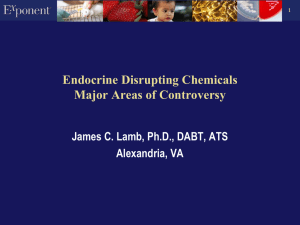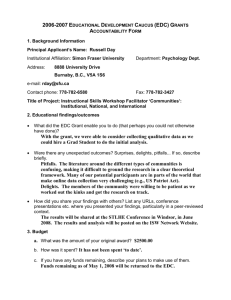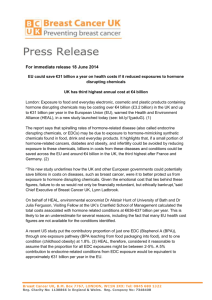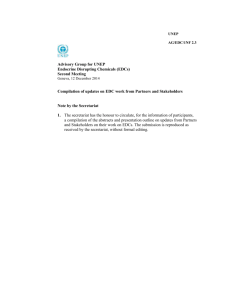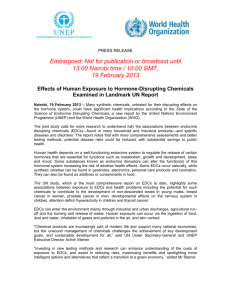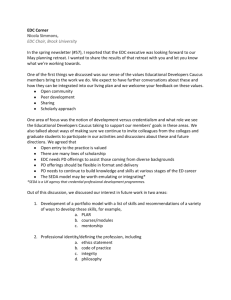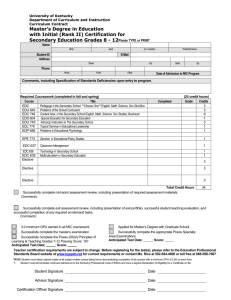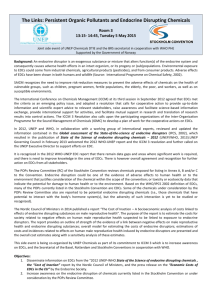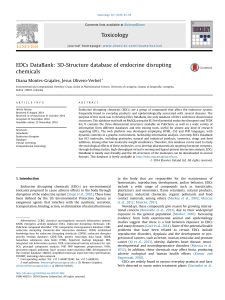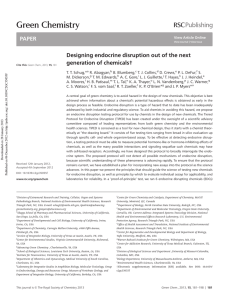M5 - UNEP
advertisement
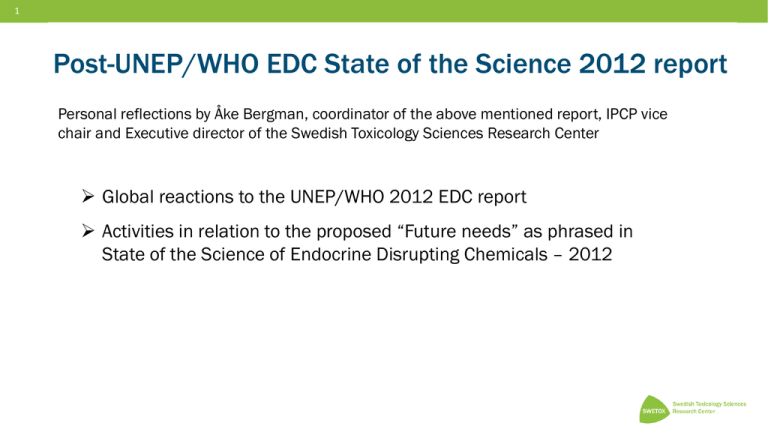
1 Post-UNEP/WHO EDC State of the Science 2012 report Personal reflections by Åke Bergman, coordinator of the above mentioned report, IPCP vice chair and Executive director of the Swedish Toxicology Sciences Research Center Global reactions to the UNEP/WHO 2012 EDC report Activities in relation to the proposed “Future needs” as phrased in State of the Science of Endocrine Disrupting Chemicals – 2012 2 Global reactions The UNEP/WHO 2012 report on EDCs has been both praised and criticized by scientists and stakeholders No specific critique regarding the “Key concerns” and none regarding the “Future needs” The report has been particularly well received at the Regional SAICM meetings during 2013/14 The report is being used for educational purposes in schools and in academia Because the UNEP/WHO 2012 report stimulated significant debate, the authors of the this report, undertook a project to evaluate the content of this debate, producing an in depth scientific discussion in a just accepted article: “A Path Forward in the Debate over Health Impacts of Endocrine Disrupting Chemicals”, Environmental Health, In press. Addressing in particular the characteristics of the debate: • Definitions of common EDC related terms (e.g. endocrine disrupting chemical, adverse effects, endocrine system. • Elements of hormone action including “potency”, “endpoints”, “timing”, “dose” and “thresholds”. • Information needed to establish sufficient evidence of harm. • The need to develop and the characteristics of transparent, systematic methods to review EDC literature. 3 Future needs A. Strengthening knowledge of EDCs The scientific data generation is speeding. Numerous new incentives, projects and articles but still limited in hormone system studied/affected and limitation in chemicals being studied Examples: Epigenetic studies; Female reproduction; Metabolic syndrome (obisity), Mixture toxicities; Exposure analyses/pathways The lack of any review of Computational toxicology for EDCs has been identified To stress: • Human toxicology/endocrine system strongly related to the corresponding systems in wildlife • The majority of hormone systems not included in EDC assessments • Lack of data on chemicals in materials and goods • Many points made under “Strengthening knowledge of EDCs” to address 4 TDCiPP, a chlorinated organophosphate flame retardant Thyroid glands: 0 µg/L TDCiPP 10 9 8 7 6 5 4 3 2 1 0 100 µg/L TDCiPP Epithelial cell height (µm) ** 0 Data from Norrgren et al., SLU 2014 *** 10 * 100 Concentration (µg/L) 1000 5 - A EU funded research project May 2009 – January 2014 7 institutes in 5 countries (NL, BE, FR, NO, SL) OBesogenic Endocrine disrupting chemicals: LInking prenatal eXposure to the development of obesity later in life* Main conclusions • Current levels of some EDCs may be a risk factor for obesity • Gender specificity • Divergent effects of pre- and postnatal exposure • Strength of study: combination of models • Mechanisms: generated new hypotheses * Data obtained from Prof. Juliette Legler, IVM, VU University Amsterdam, The Netherlands 5 6 Future needs B. Improved testing for EDCs. Just one example of what’s going on in OECD (aquatic testing) Gastropod reproduction tests (EDC) Fish Embryo Toxicity Test (General tier 1) Fish 21-day screening assay (EDC) Fish sexual development test (EDC) Fish full life-cycle test (EDC) Amphibian Metamorphosis Assay (EDC) 6 7 Future needs C. Reducing exposures and thereby vulnerability to disease D. Identifying endocrine active substances No specific comments. The needs is still valid. Declaration of chemicals in materials and goods a prerequisite for going forward to reduce exposures A very recent example: Chlorinated paraffins leaking from hand blenders into food. M5 Brand: OBH Nordica, Kitchen, Quickmix Model: 6705 Production country: Not specified Maximum blending time: 10 sec. intervals, 1 min. 6 000000 µV M5 5 000000 4 000000 3 000000 2 000000 1 000000 5 6 7 8 9 10 11 12 13 14 15 Bergman et al., 2014 Reports to the Swedish Chemicals Agency and National Food Agency 16 Min. 7 8 Future needs E. Create enabling environments for scientific advances, innovations and disease prevention Two Nordic initiatives during 2014: International Center for Research and Research Training in Endocrine Disruption of Male Reproduction and Child Health- EDMaRC Swedish Toxicology Sciences Research Center (Swetox) with focus on: EDCs Nanosafety Toxicology and environmental effects of pharmaceuticals and to be a Watch dog regarding emerging chemicals, health and environment issues. 8 9 Future needs F. Methods for evaluating evidence Ongoing international project “Proposal for a framework for systematic review and assessment of endocrine disruption” – a project including some 20-30 professionals from academia and authorities. 9
